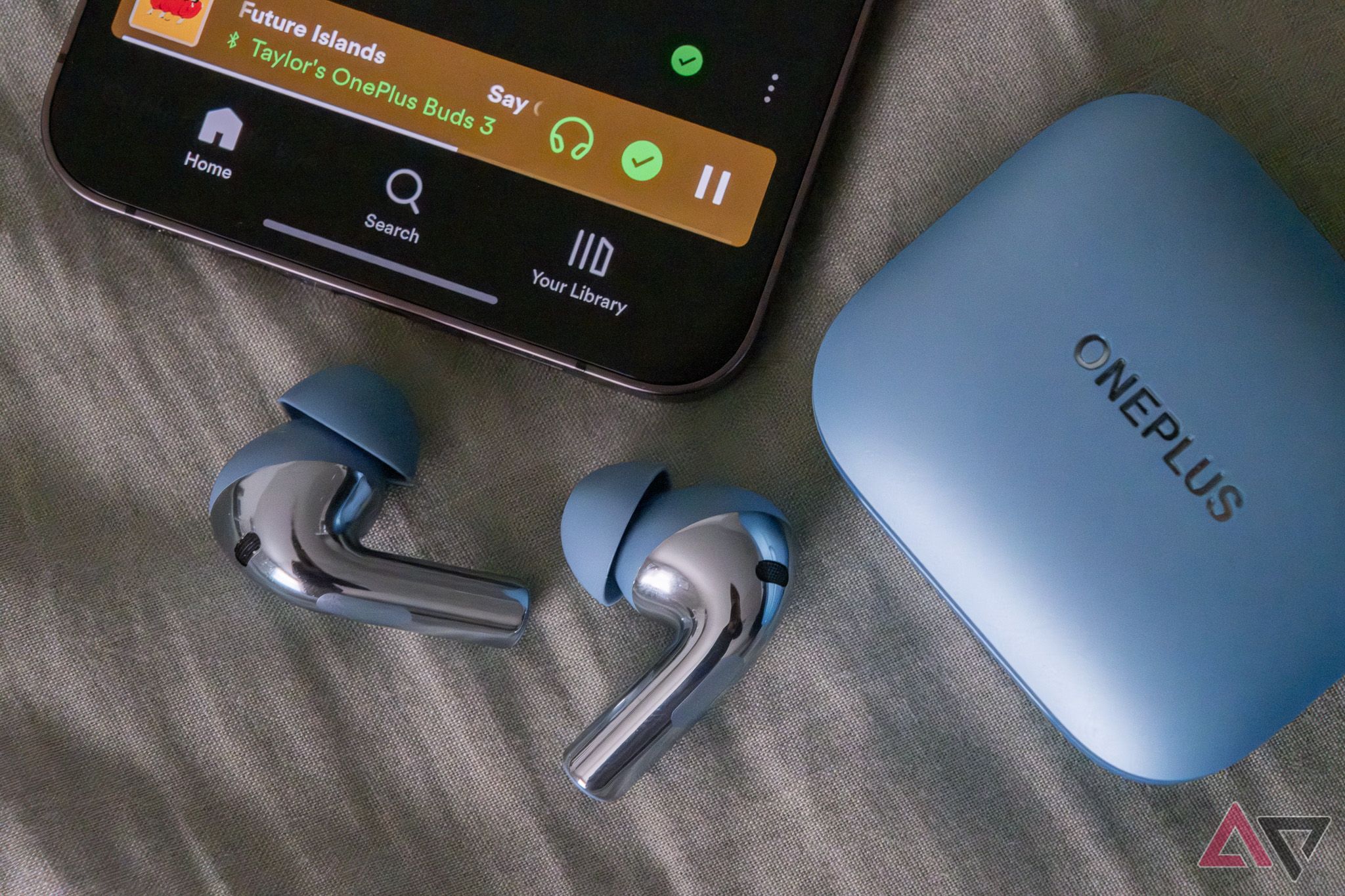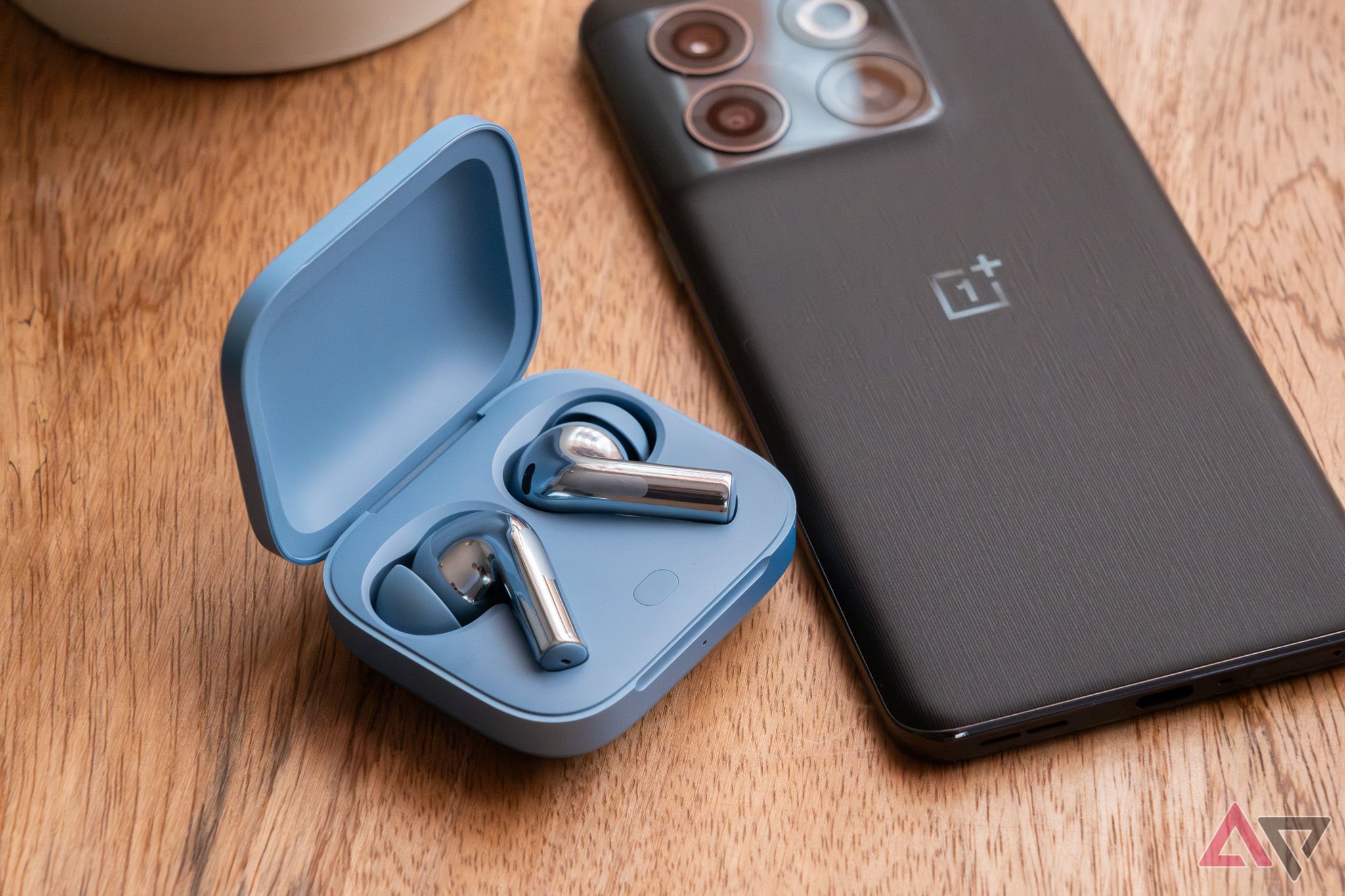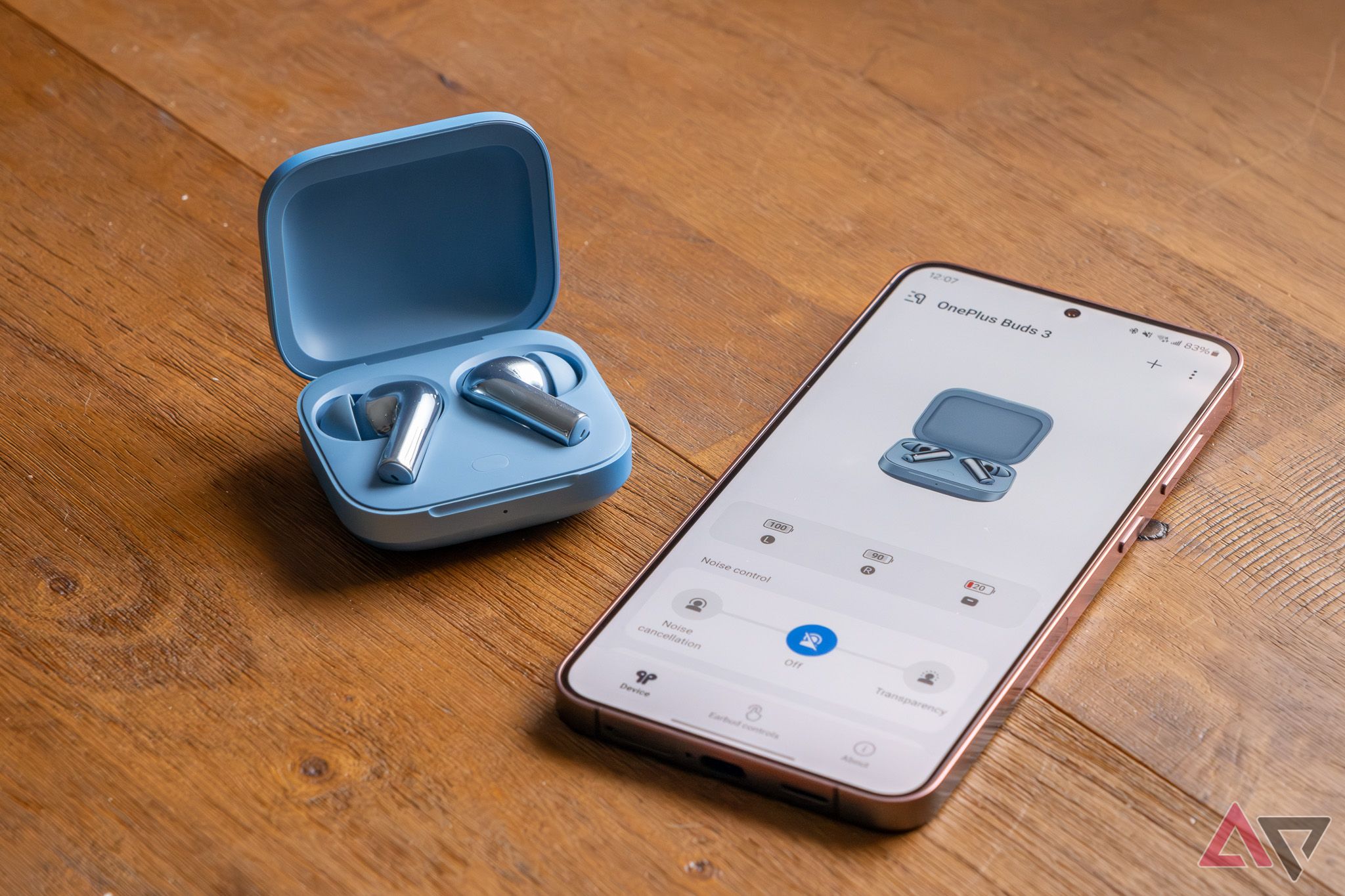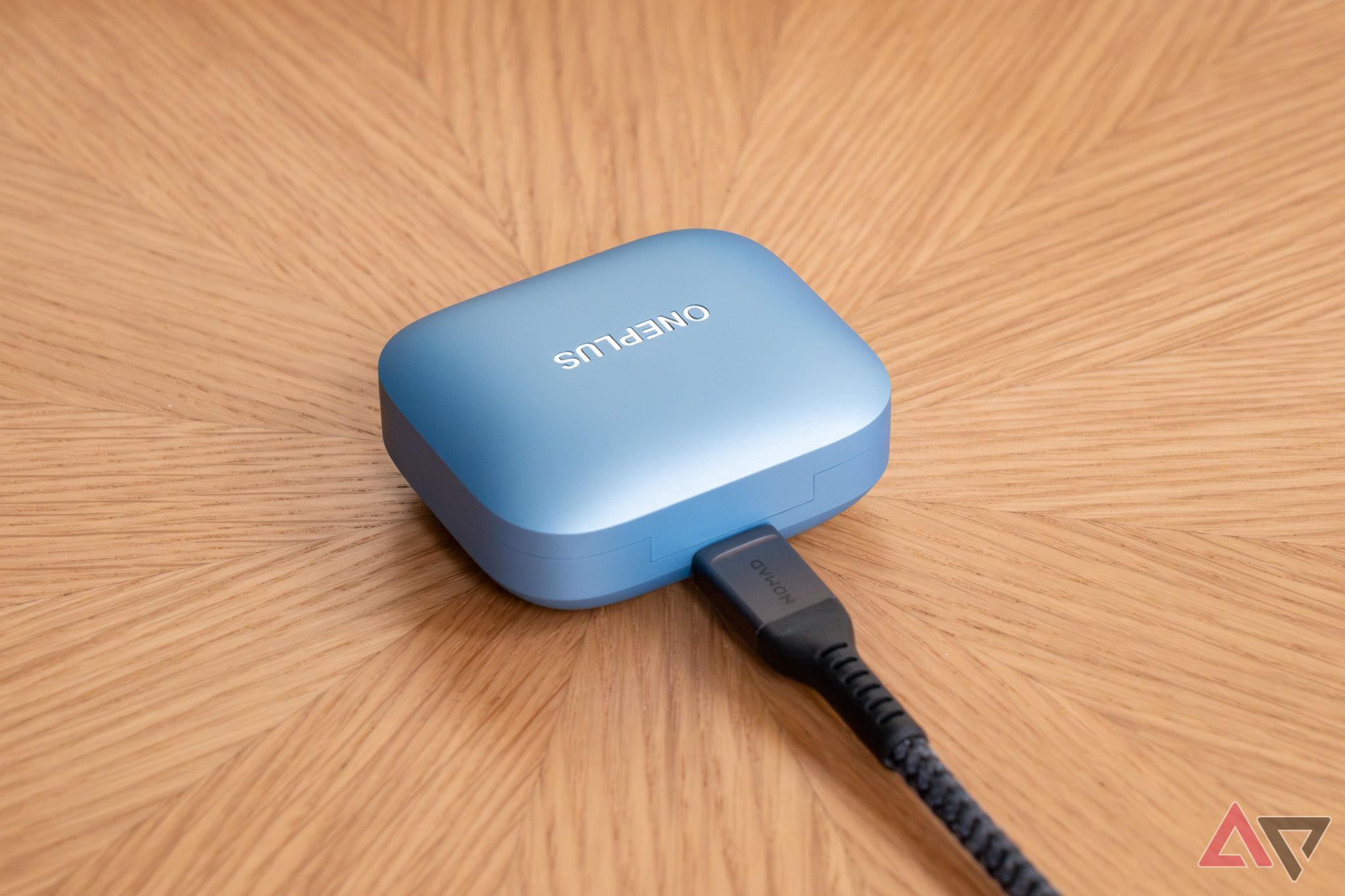-

OnePlus Buds 3
Midrange marvels
OnePlus has shaken up the midrange headphone market with its Buds 3, a fascinating new set of true wireless earbuds that deliver great value, with good sound, strong battery life, and competent ANC for their affordable price tag, plus a classier design than most earbuds in their class.
Pros- Generally good audio quality
- Feature-rich and versatile
- Classy design
Cons- Sound balance falls off at higher volumes
- ANC isn’t anything to write home about
- No wireless charging
-

Google Pixel Buds A-Series
Aging gracefully
$94 $99 Save $5
Google’s Pixel Buds A-Series still hold their own for audio quality and comfort. However, they’re starting to show their age as other affordable options introduce features the buds lack, like ANC and multipoint connectivity. Still, the vented design makes them great for those who want to stay in touch with the outside world.
Pros- Good sound at an affordable price
- Pressure vents offer comfort and transparency
- Available in fun colors
Cons- No ANC
- Mediocre battery life
- No wireless charging
There’s a growing market for affordable true wireless earbuds that can still deliver solid sound quality while not skimping on additional features like active noise cancellation. Over the past year, we’ve seen some interesting new entries in the sub-$100 price range from Samsung, Jabra, Sony, and even boutique brands like Cambridge Audio. Now, OnePlus is throwing its hat into the ring with the OnePlus Buds 3, a set of midrange earbuds that sit between the company’s almost ridiculously inexpensive Nord Buds 2 and its flagship OnePlus Buds Pro 2.
They’re a fascinating new entry into a space that was once dominated by Google’s Pixel Buds A-Series but has become far more competitive over the last year. Are OnePlus’ new buds a worthy contender against Google’s originals? Let’s find out.

Best cheap true wireless earbuds in 2024
These exceptional earbuds won’t break the bank while still delivering quality
Price, availability, and specs
The OnePlus Buds 3 launched in early 2024 and can be purchased for $100 from Amazon or directly from the OnePlus website. They’re available in Splendid Blue or Metallic Gray with a matching case.
On the other hand, Google’s Pixel Buds A-Series have been around for nearly three years now, having launched in June 2021. This means that even though they’re still officially priced at $99, it’s not hard to find them on sale for much less. They’re available in Charcoal, Clearly White, Dark Olive, and Sea.
-
OnePlus Buds 3 Google Pixel Buds A-Series Battery Life 6.5 hours (with ANC), additional 21.5 hours with case 5 hours (24 with case) Noise Cancellation Yes No IP rating IP55 IPX4 (earbuds only) Supported codecs AAC, SBC, LHDC AAC, SBC Charging USB-C USB-C Driver size 10.4mm woofer + 6mm tweeter 12mm Price $100 $99

OnePlus Buds 3 review: Right down the middle
✓ Decent audio ✓ ANC ✓ $100

Google Pixel Buds A-Series review: Basic, but not bad
Google’s $99 earbuds are fine
Design & fit
Stylish and comfortable
Nobody is about to accuse the OnePlus Buds 3 of breaking new ground in design, but the company has still given them enough flair so they feel like a good fit for the OnePlus family.
While the overall style is reminiscent of Apple’s AirPods Pro, the blue and gray colors and metallic sheen on the stems set them apart nicely. Don’t be fooled by the marketing images, though, as the Splendid Blue stems are much more of a silver color that merely reflects the surrounding blue. The Metallic Gray is more faithful to its photos, with an obsidian-like sheen on the stems. Just be aware that the glossy finish is every bit the fingerprint-magnet that you’d expect.
In contrast, Google’s Pixel Buds A-Series feature a rounded stemless design that has an inner ear hook to keep them snugly inserted. There are also pressure vents offering more comfort than most earbuds, but that’s a trade-off that ANC-equipped earbuds like the Buds 3 can’t afford to make.
The OnePlus Buds 3 and Pixel Buds A-Series both use touch-sensitive controls that lack any haptic feedback, but where Google’s buds are limited to simple taps to play, pause, switch tracks, answer calls, or call up Google Assistant, the OnePlus Buds 3 add a slide gesture that can be used to adjust the volume. That’s something you’ll need to pull out your phone to do with the Pixel Buds.
Both earbud sets include the usual three sizes of ear tips and the accompanying charging case. The cases for the OnePlus Buds 3 match the blue and gray colorways, while the Pixel Buds A-Series offers a broader color array but only adds that splash of color to the inside of the case, offering basic white on the outside.
The OnePlus Buds 3 come out a bit ahead in durability, with an IP55 rating for dust and water resistance, versus IPX4 for Google’s earbuds. You still won’t want to let them take a dunk, but IP55 is a respectable rating for true wireless earbuds in any price range. However, neither case is rated for any dust or water resistance.
Sound & call quality
Impressive sound, middling ANC
The OnePlus Buds 3 earbuds’ dual-driver configuration is one pleasant surprise. Unlike many other earbuds in this price range, each earbud packs a 10.4mm woofer and a 6mm tweeter. This gives them a surprisingly good bass response, although you won’t hear it out of the box as they don’t seem to have a bass-forward tuning by default. We found that we needed to make a few simple tweaks in the companion app’s equalizer to get the bass to where it needed to be for hard-driving genres like heavy rock, EDM, and hip-hop. Once there, however, the Buds 3 sounded remarkably good for a set of headphones in their class.
Codecs and sound signature
Naturally, you shouldn’t expect the sound to rival even OnePlus’ Buds Pro 2, much less other high-end options. However, you’re getting what you’re paying for here, and possibly a bit more. There aren’t any mainstream high-resolution codecs — only SBC and AAC — unless you count the relatively LHDC 5.0 that’s found on OnePlus and Nothing phones, but not much elsewhere.
In our listening tests, the high-end got a bit exaggerated when we cranked up the volume. This was likely a consequence of the discrete tweeter in each earbud and was something we couldn’t entirely compensate for with the EQ settings. It’s not a serious problem even when it does occur, and since it only kicks in at high volumes, many folks won’t be bothered by it at all.
The Google Pixel Buds A-Series also deliver impressive audio for their price, especially considering they incorporate only a single 12mm custom driver in each bud to handle the entire sound spectrum. The Bluetooth codecs are similarly limited to SBC and AAC, but the sound is clear and crisp, and bass is present, even if it’s a bit less refined. The Pixel Buds A-Series lean more toward vocals in their default tuning, making them great for things like Zoom calls and Podcasts, but while there are no EQ settings, there is a bass boost that kicks in a decent amount of low-end when you want it.
Active noise cancellation
The OnePlus Buds 3 have a slight edge in sound quality, but they really pull ahead by offering ANC support — something the Pixel Buds A-Series lacks entirely. Google has tried to address this with an Adaptive Sound feature that automatically adjusts the volume to compensate for the surrounding noise (and might explain why the buds lack onboard volume controls). It doesn’t even come close to ANC, as it’s really just turning up the volume to drown out the din around you.
That’s not to say the ANC in the OnePlus Buds 3 is particularly stellar, but at least it’s there. It’s enough to take the edge off environmental background noises like traffic and jet engines, but you’ll have to crank up the volume if you want to drown everything out. The Buds 3 lack a proper transparency mode, but you can compensate for that by using the Smart Scene noise cancellation setting, which tries to automatically adjust the ANC to match your environment. There are also three intensity levels — Mild, Moderate, and Max — to choose from if you’d rather control the ANC directly. The ANC is decent for headphones in this price range, but it’s not the best we’ve experienced.
Call quality
The mics on the OnePlus Buds 3 provide good clarity for voice calls, although the protruding stems undoubtedly help. OnePlus boasts an AI Clear Call algorithm that uses additional built-in mics to cut out wind and other background noises. The Pixel Buds A-Series are no slouches here, though, and are also enhanced by similar background noise filters. While we’re not fans of Google’s Adaptive Sound for music, it comes into its own for phone calls since it can automatically raise the volume when things around you get louder to ensure you can still hear the person you’re talking to.
Software
Flexible sound
OnePlus offers a HeyMelody app for Android and iOS that mirrors nearly all the capabilities you’ll get by pairing the OnePlus Buds 3 with a OnePlus phone. That’s a refreshing level of openness from OnePlus’ prior earbuds, which reserved some features like Spatial Audio for their own smartphones and tablets.
The most useful part of HeyMelody is a six-band equalizer, which, as we mentioned earlier, you’ll likely need to get the sound curve to match your preferred listening style. Beyond that, HeyMelody can enable Hi-Res audio on phones that support LHDC 4.0 or later, set up a custom sound profile for the shape of your ears with Audio ID 2.0, and enable 3D audio.
The Buds 3 still have one OnePlus-exclusive trick up their sleeves, the Pro Gaming mode, which can reduce Bluetooth latency down to 94ms. However, this latency level is available only when the buds are paired with compatible OnePlus phones.
The tap gestures on the Buds 3 are also quite flexible; HeyMelody can be used to assign up to three functions separately to each earbud via single, double, and triple taps. Single-tap gestures are off by default, likely to avoid interfering with the volume slider, but you can enable them manually and even assign a single tap for play/pause on only one earbud while using the other exclusively for volume control.
Google’s Pixel Buds A-Series are powered by the Pixel Buds app. This is where iPhone users need not apply — the app is unsurprisingly only available for Android devices. That doesn’t mean you can’t pair the Pixel Buds with an iPhone using standard Bluetooth, but you’ll have no options for configuring them or even updating their firmware. When used with any Android device (not just a Pixel phone), you get voice-activated Google Assistant and the ability to customize the touch controls, adjust other features of the earbuds, and activate the bass boost.
Battery life
One clear winner
OnePlus claims the Buds 3 can run for up to 44 hours with the charging case in the mix, but that’s without ANC and with the volume at 50%. In that mode, the earbuds will run for 10 hours on a single charge.
However, switch on ANC, and OnePlus says the run time drops to about 28 hours — 6.5 from the earbuds, plus a little over three more charges from the case. Fast charging also lets you top up the earbuds from the case, with a 10-minute charge giving you two more hours of listening time.
Those run times are effectively twice what the Google Pixel Buds A-Series will give you. Google promises five hours of listening time on a single charge plus an additional 15 hours from the case. However, remember that’s without factoring in ANC, as the Pixel Buds A-Series don’t have it.
The cases for the Pixel Buds A-Series and OnePlus Buds 3 charge up using a standard USB-C connection, but there’s no wireless charging support here.
Which is right for you?
For most folks, we think the OnePlus Buds 3 are the clear winner here. They check all the right boxes for good sound quality, long battery life, and other features. The ANC isn’t anything to write home about, but it’s competent for earbuds at this price, and it’s something Google’s Pixel Buds A-Series doesn’t offer at all.
While design is subjective, we also like what OnePlus has done here with glossy metallic finishes that help set the Buds 3 apart from Google’s more pedestrian A-series buds.

OnePlus Buds 3
Editor’s pick
Great sound quality and ANC for the price
The OnePlus Buds 3 are a solid new entry from the enthusiast smartphone brand, featuring a glossy metallic design with solid sound quality and competent ANC. OnePlus has cut some corners here, but they’re mostly the right ones, and the Buds 3 deliver good value.
Nevertheless, Google’s aging Pixel Buds A-Series still have a place, especially for folks entrenched in the Google ecosystem or who simply want a pair of earbuds that keep them aware of the world around them. You get voice-activated Google Assistant support, and the pressure vents will let outside sounds through in a way that most earbuds don’t. This also improves comfort for those who don’t like having their ears plugged. They’re earbuds that are so light and comfortable you can easily forget you’re wearing them, and they come in some fun colors, too.

Google Pixel Buds A-Series
Still in the running
Classic buds that remain relevant
$94 $99 Save $5
Google’s Pixel Buds A-Series once defined the market for affordable true wireless earbuds, but they’re starting to show their age, lacking features like ANC and multipoint connectivity in an era when more affordable headphones are catching up. However, they still deliver good audio quality and a comfortable lightweight fit.
Source link








